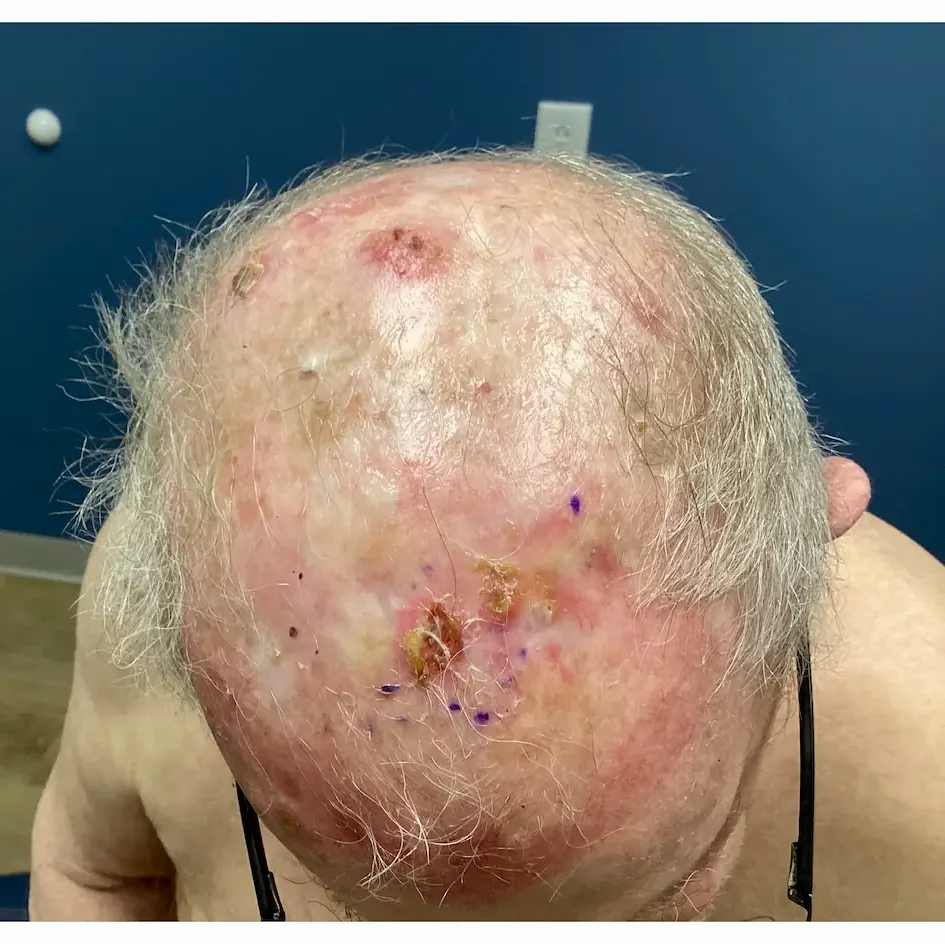Actinic Keratosis
Actinic keratosis (AK) is a common skin condition that appears as rough, scaly patches or spots on areas frequently exposed to the sun.

Early Detection & Expert Care for Precancerous Skin Lesions
Actinic keratosis (AK) is a common skin condition that appears as rough, scaly patches or spots on areas frequently exposed to the sun. While these lesions may seem minor at first, they are classified as precancerous, and without proper treatment, they can develop into squamous cell carcinoma (SCC)—a form of skin cancer.
What Is Actinic Keratosis?
Actinic keratosis is a skin lesion caused by long-term exposure to ultraviolet (UV) radiation from sunlight or indoor tanning. It often develops on sun-exposed areas such as the:
- Face
- Scalp
- Ears
- Neck
- Forearms
- Backs of the hands
AKs typically appear as small, dry, or scaly patches that may be pink, red, brown, or skin-colored. Some patients experience itching, tenderness, or burning, though many cases are asymptomatic.
Why Actinic Keratosis Requires Medical Attention
Actinic keratosis is considered precancerous, meaning it has the potential to turn into squamous cell carcinoma if left untreated. Although not every AK will become cancerous, there’s no way to predict which ones will. That’s why early evaluation and treatment by a board-certified dermatologist is essential.
Key reasons to take AK seriously:
- Up to 10% of AKs can become squamous cell carcinoma
- Having multiple AKs increases overall cancer risk
- AKs are signs of chronic sun damage that can affect other areas of the skin
What Causes Actinic Keratosis?
The primary cause of AK is chronic exposure to UV radiation, whether from natural sunlight or artificial sources like tanning beds. The skin becomes damaged at a cellular level, leading to abnormal growths on the outermost layer of the skin.
Risk Factors Include:
- Fair skin, light eyes, or red/blonde hair
- History of frequent sunburns
- Living or working outdoors (e.g., farmers, landscapers, construction workers)
- Age 40+
- Immunosuppression (e.g., organ transplant recipients)
What Does Actinic Keratosis Look Like?
AKs can vary widely in appearance, which makes self-diagnosis difficult. They may:
- Feel like rough, sandpaper-like spots
- Appear as flat or slightly raised patches
- Be pink, red, tan, or flesh-colored
- Flake, peel, or crust
- Sometimes itches or gets inflamed
These spots often go unnoticed until they multiply or become irritated.
If you notice any persistent or unusual changes to your skin, particularly in sun-exposed areas, schedule an exam with our dermatology team.
How Is Actinic Keratosis Diagnosed?
At St. Louis Dermatology & Cosmetic Surgery, we provide thorough skin evaluations using advanced diagnostic tools. During your visit, we will:
- Conduct a full skin examination
- Use dermatoscopy to magnify and evaluate lesions
- Perform a biopsy if a lesion appears suspicious or irregular
Early detection allows for simpler, more effective treatment options—and peace of mind.
Prevention and Long-Term Skin Health
Preventing actinic keratosis starts with sun safety. Even after treatment, new lesions may appear over time due to cumulative sun damage.
Tips to Prevent AK:
- Use broad-spectrum sunscreen SPF 30+ daily
- Wear protective clothing, hats, and sunglasses
- Avoid tanning beds
- Perform monthly self-skin checks
- Visit your dermatologist at least once a year for professional skin exams

If you’ve been treated for AK in the past, ongoing dermatologic care is essential for monitoring and preventing recurrence.
Why Choose Us for Actinic Keratosis Treatment?
At St. Louis Dermatology & Cosmetic Surgery, we provide comprehensive skin cancer prevention and treatment, combining advanced technology with compassionate care. Our providers are experts in identifying, treating, and monitoring sun damage in patients from across Lincoln County, St. Charles County, and surrounding Missouri communities.
Our Advantages:
- Board-certified dermatology and cosmetic surgery team
- Same-week appointments for suspicious lesions
- Personalized treatment plans
- On-site procedures with minimal downtime
- Focus on both skin health and cosmetic outcomes
Schedule a Skin Check in Troy, MO
If you’ve noticed a rough, scaly patch or have a history of sun exposure, don’t wait. Early treatment of actinic keratosis can prevent the development of skin cancer—and protect your long-term skin health.
📞 Call us today or book online to schedule your skin evaluation.
GET IN TOUCH
